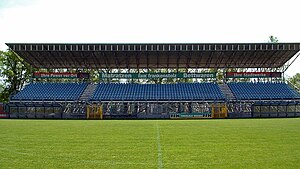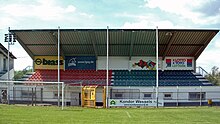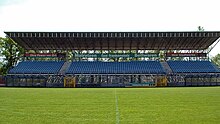Stadium am Schönbusch
| Stadium am Schönbusch | |
|---|---|

|
|
| The main grandstand built in 1999 | |
| Data | |
| place | Kleine Schönbuschallee 92 63741 Aschaffenburg , Germany |
| Coordinates | 49 ° 58 '13.2 " N , 9 ° 7' 47.9" E |
| owner | City of Aschaffenburg |
| opening | May 23, 1909 |
| First game | SV Viktoria 01 - 1. Hanauer FC 1893 7-1 |
| Renovations | 1946, 1993, 2008 |
| surface | Natural grass |
| capacity | 6,620 |
| playing area | 109 m × 70 m |
| Societies) | |
The Stadion am Schönbusch is a football stadium in the Lower Franconian city of Aschaffenburg , Bavaria . The sports facility, inaugurated in 1909, offers 6620 seats. It is the venue of the regional league team Viktoria Aschaffenburg and is also used by the American football team of the Aschaffenburg Stallions as the venue for their home games. The venue has been in use since 1909, making it one of the oldest and most traditional in German football.
history
The history of the stadium is closely linked to the Viktoria Aschaffenburg football club. Viktoria owned the land and buildings for decades until financial problems made the sale necessary in the early 1990s. But even if the stadium is now owned by the city of Aschaffenburg , construction projects financed by Viktoria are still being carried out.
The beginnings
The venue at Schönbusch was inaugurated on May 23, 1909. The opening games against the first and second team of 1. Hanauer FC 1893 took place in front of 1200 spectators and were won 7: 1 and 2: 1. The changing room, inaugurated on May 4, 1921, with bathrooms that had cold and hot water supplies was unique in southern Germany at that time. Since some games attracted more than 4,000 spectators to Schönbusch in the twenties, the first grandstand was built in the stadium on May 6, 1923. It was made of wood and had 400 seats. During the Second World War , the grandstand was destroyed and the pitch was damaged by bombs.
Full house on Schönbusch
After the Second World War, the lack of a grandstand and standing stands limited the capacity to around 8,000 spectators and was maxed out for games such as against the club . For this reason, standing stands and a new grandstand were built, which expanded the capacity to 12,000 spectators. The record number of spectators at the stadium on Schönbusch dates from this time and is still in place today: Even a specially built tubular steel grandstand during the game against the clubbers on November 11, 1951, could not prevent ticket sales from having to stop after 18,000 tickets. An average of five figures in attendance during these years, for example an average of 13,000 spectators per game in the 1952/53 season, regularly filled the stadium almost to its limits. In 1954 the number of 18,000 spectators was reached again - again with 1. FC Nürnberg as an opponent.
Black Friday and empty ranks
On Friday, August 22, 1958, the main stand, which could hold 700 spectators, burned down as a result of arson, interior furnishings and sports equipment were destroyed, and the pitch was damaged. The grandstand was rebuilt within three weeks, and the pitch was later repaired by the club with the help of volunteers and US soldiers. With the relegation from the Oberliga Süd in 1959/60 and the subsequent low class, the stadium's capacity was not exhausted for decades, even if regional league games against well-known opponents such as TSV 1860 Munich or 1. FC Nuremberg attracted between 8,000 and 10,000 spectators.
Preparations and conversions for league two
In 1984 the stadium had a capacity of 10,500 spectators, according to the building inspectorate, of which 650 could be seated in the stands. In order to be able to survive financially in the event of promotion to the Second Bundesliga, the seating capacity was expanded to 1,200 covered seats by a newly built grandstand. The new building was inaugurated on May 13, 1985 after a construction period of five weeks; the construction costs amounted to 500,000 marks. Another 200,000 marks were spent on upgrading the stadium to make it suitable for the Bundesliga. Before the second season in the second division, the standing ranks were renovated in 1986 and provided with breakwaters. The city of Aschaffenburg assumed the cost of DM 47,000. In 1986 only three of the 38 stadiums in the first and second Bundesliga were owned by the respective clubs, including the stadium at Schönbusch. The other venues were in municipal hands. The financial situation, which was troubled by the investments of more than DM 700,000, prompted Viktoria to sell the stadium to the city of Aschaffenburg in order to be able to use the proceeds to build a further 3,000-seat grandstand. The city declined the offer, although it already owned three quarters of the property through acquisitions. After the promotion to the Second Bundesliga in 1989, the electronic scoreboard, which is still in use today, was installed, and a second VIP room was set up under the newer grandstand. The donation of 100,000 marks from the patron Alois Ammerschläger allowed the expansion of the shower and sanitary facilities, the installation of a dehydration basin, a referee's room and an office room. In order to pay for the club's previous investments, he bought the stadium for 700,000 marks and donated it to the city of Aschaffenburg on condition that the entire stadium be renovated.
The 90 ° turn
Under pressure from Alois Ammerschläger, the first plans for the complete renovation of the stadium were made: a reorganization of the standing stands, a grandstand on the back straight and a floodlight system were to be implemented. The most obvious change was the rotation of the entire playing field by 90 °. This should ensure that the floodlight masts do not interfere with the visual axis between the castle in Schönbusch Park and Johannisburg Castle , which would have violated the Bavarian Castles and Lakes Ordinance. On a sketch by the municipal planning office, the playing field was surrounded on all four sides with covered standing and seating stands and was framed by a floodlight system. Construction work began in 1992 shortly before the promotion to the second division. The promotion games took place in a construction site that had been robbed of many places in front of only around 7,000 spectators. In order to carry out the further renovation, the stadium was closed for a year, the Viktoria played their games on a sports field in the Damm district. The first phase of construction was completed on June 13, 1993, the first game in the new stadium was played by Viktoria on September 3, 1993. The field, which has now been rotated by 90 degrees, complied with international requirements with its 105 × 70 meters, and the cost was 1.5 million marks. Since Viktoria missed promotion to the Second Bundesliga and also only played in the regional league for one year, the planned construction of the new grandstand and the floodlight system was postponed indefinitely until there was a need for it due to sporting success.
The wasteland at Schönbusch
Due to the lack of a second renovation phase, the stadium remained in an unfinished state with considerable disadvantages: due to the rotation of the field, the former main stands became back-end stands, the sale of seat tickets and thus an important part of the income increased in the following years due to poor visibility significantly. The club put the loss of income at 30,000 marks per season. Furthermore, one side of the back straight was completely deserted: Behind the fence surrounding the field of play, there was a forty-meter-wide gravel level along the entire length of the field up to the outer boundary of the stadium. Long-time spectators still regret the loss of the crowded atmosphere of the old stadium. Due to the spacious open area behind the back straight, the battle cries of the supporters were lost. The then team captain Thomas Biehrer said, comparing the two conditions of the stadium: In the old stadium, you got goose bumps with 1,500 spectators. Today everything runs smoothly, there is no more mood. Despite all the protests, the city of Aschaffenburg saw itself as the owner not in a position to fully carry out the second construction phase: On the one hand, neither the sporting requirements that justified the further renovation were met, nor did the city have the necessary financial resources. For the time being, the building of twelve new ticket booths remained - costs: more than 320,000 marks. When the construction of a grandstand on the still vacant back straight was not considered again until 1997, the planning no longer provided for a variant that could hold 3,000 spectators, but only a shortened grandstand with a capacity of 1,000. However, the city announced this plan, too, but did not implement it.
The club tackles: the new main stand
Since the club did not see itself supported by the city, Viktoria built a roofed tubular steel grandstand in the city stadium with the help of an advertising partner in 1999. This makeshift construction should be operational for around 20 years, is 58 meters long and has almost 1,100 seats. With the construction of the main stand and the extension of the standing stands to a section of the back straight that is still free in places, at least part of the then notorious atmosphere of the stadium at Schönbusch was restored.
The stadium today
The city of Aschaffenburg puts the capacity at 6620 spectators. One side of the back straight, as well as one side of the goal, are provided with upright strings including breakwaters, whereby these upright strings also extend over a piece of the other back straight. On this side is the roofed main grandstand with 1040 seats. The other rear side of the gate is dominated by two covered grandstands with 946 seats. The official number of seats is given as 1,986. The VIP and changing rooms, some offices and the stadium bar “Stadion Stüberl” are located under the stands behind the gate. This is currently being renovated by the city and will house the fan shop in the future. The playing field is surrounded by a security fence that has around a dozen goals. A tunnel formed by lattice gates allows the players and officials to move safely from the players' cabins to the field. There are twelve ticket booths on three of the four outer sides of the stadium, on two opposite sides of the property there are a total of three buildings with toilets and catering stands, as well as two smaller sales kiosks on one side of the property facing Darmstädter Straße. A monochrome, two-line display board provides information on the score and team lineups.
After successfully qualifying for the reorganized Regionalliga Süd , the city began renovating the stadium in July 2009. Among other things, three fences were erected, which divide the previously completely open area into several sectors.
The city of Aschaffenburg is currently not actively pursuing the construction of a floodlight system.
Football internationals
In recognition of the good youth work of SV Viktoria Aschaffenburg , the DFB awards (junior) international matches to Schönbusch at irregular intervals. The highlight so far has been a qualifying game for the 2003 Women's World Cup for the German women's national team .
German women's national team
| April 18, 2002, World Cup qualification | |||
|
|
- |
|
6: 0 (3: 0) |
German U-21 national team
| April 17th 1984, friendly match | |||
|
|
- |
|
0: 0 (0: 0) |
| May 31, 2000, friendly match | |||
|
|
- |
|
2: 2 (1: 1) |
German U-20 women's national team
| July 15th 2012, friendly match | |||
|
|
- |
|
5: 0 (2: 0) |
German U-19 national team
| September 14th 2005, friendly match | |||
|
|
- |
|
2: 0 (1: 0) |
German U-17 national team
| October 19, 2008, friendly match | |||
|
|
- |
|
0: 0 (0: 0) |
Oddities
In 1993 the playing field had to be turned by 90 °. The reason for this was the Bavarian Castles and Lakes Ordinance. If a floodlight system had been set up, the floodlight masts would have impaired the line of sight between the Aschaffenburg Johannisburg Palace and the Schönbusch garden palace. This is no longer possible due to the new arrangement.
Panorama picture
literature
- Support group SV Viktoria Aschaffenburg: The way up , Aschaffenburg 1986.
- Wolfgang Rath (Ed.): 100 years SV Viktoria 01 e. V. Aschaffenburg , Verlag Schmidt, Neustadt 2003, ISBN 978-3-87707-617-0 .
- Werner Skrentny (Hrsg.): The big book of the German football stadiums. Verlag Die Werkstatt, Göttingen 2001, ISBN 3-89533-306-9 , pp. 18-19.
Web links
- Fan page with some photos of the stadium
- Another page with photos
- View of the stadium from the air
- Visitor report from 2001
Individual evidence
- ^ City of Aschaffenburg: Stadion am Schönbusch. City of Aschaffenburg, accessed on December 4, 2018 .
- ^ Stadium am Schönbusch. In: sva01.de. Retrieved December 8, 2016 .
- ^ Matthias Hunger: Guest block: Stadion am Schönbusch. In: Zeitspiel. # 4, II / 2016, ISSN 2365-3175 , pp. 16-17.
- ↑ Wolfgang Rath (Ed.): 100 years SV Viktoria 01 e. V. Aschaffenburg. Verlag Schmidt, Neustadt 2003, ISBN 978-3-87707-617-0 , p. 201.
- ↑ Werner Skrentny (ed.): The big book of the German football stadiums. Verlag Die Werkstatt, Göttingen 2001, ISBN 3-89533-306-9 , p. 18.
- ↑ Werner Skrentny (ed.): The big book of the German football stadiums. Verlag Die Werkstatt, Göttingen 2001, ISBN 3-89533-306-9 , p. 19.
- ↑ Wolfgang Rath (Ed.): 100 years SV Viktoria 01 e. V. Aschaffenburg. Verlag Schmidt, Neustadt 2003, ISBN 978-3-87707-617-0 , p. 204.
- ↑ Wolfgang Rath (Ed.): 100 years SV Viktoria 01 e. V. Aschaffenburg. Verlag Schmidt, Neustadt 2003, ISBN 978-3-87707-617-0 , p. 207.
- ↑ Wolfgang Rath (Ed.): 100 years SV Viktoria 01 e. V. Aschaffenburg. Verlag Schmidt, Neustadt 2003, ISBN 978-3-87707-617-0 , p. 208.
- ^ Matthias Hunger: Guest block: Stadion am Schönbusch. In: Zeitspiel. # 4, II / 2016, ISSN 2365-3175 , pp. 16-17.
- ^ Matthias Hunger: Guest block: Stadion am Schönbusch. In: Zeitspiel. # 4, II / 2016, ISSN 2365-3175 , pp. 16-17.



